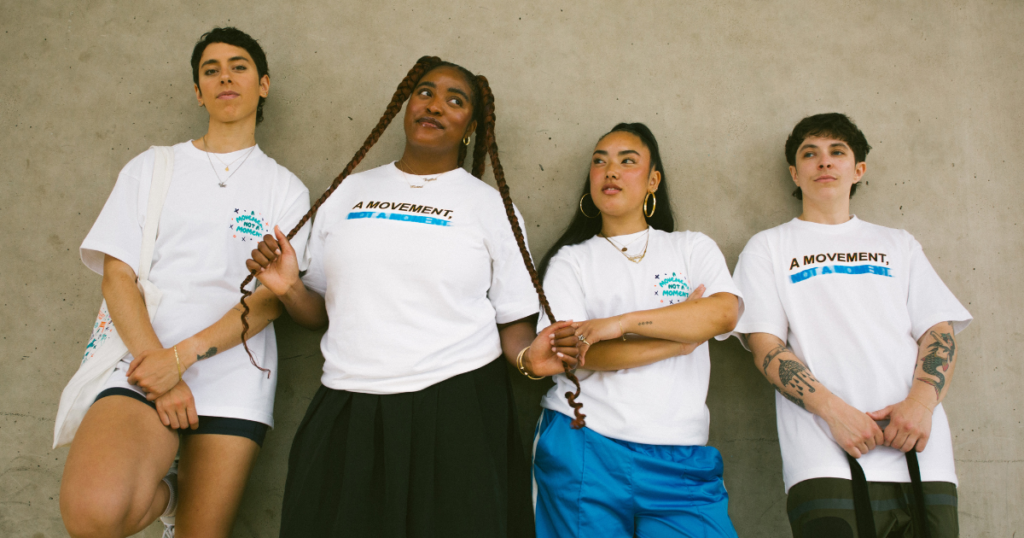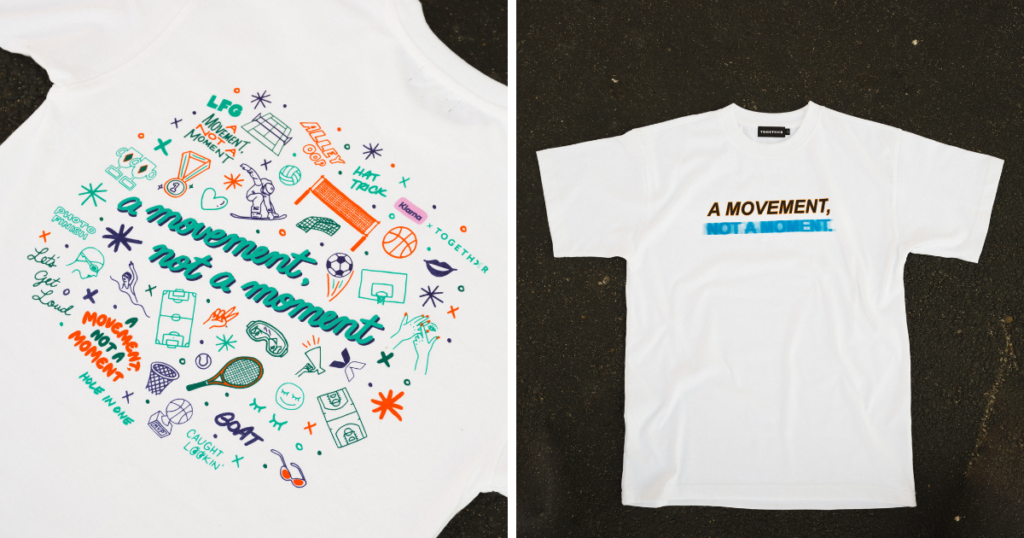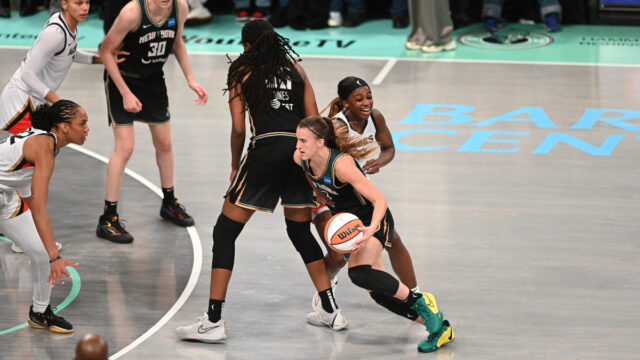Brands Are Missing Out on the $4 Billion Women’s Sports Merch Market
The athletes and partners in women’s sports would give the shirts off their backs to keep the game growing—if those shirts were available.
During big events in women’s soccer and basketball within the last year, sports apparel makers have had difficulty meeting the moment. During England’s run to last year’s Women’s World Cup Final, goalkeeper Mary Earps questioned why Nike hadn’t made her jersey available to fans during the tournament. Nike didn’t release Earps’ jersey until months later, but Earps believed it learned a harsh sports marketing lesson.
Then, after collegiate record breaker Caitlin Clark was drafted No. 1 overall by the WNBA’s Indiana Fever in April, fans ordering her Nike-made jersey from Fanatics and Dick’s Sporting Goods were given delivery dates ranging from mid-August to early October. Nike-produced jerseys for Caleb Williams—selected first overall in the NFL Draft by the Chicago Bears—ship the day after they’re ordered.
To highlight the disparity between apparel availability and selection in men’s and women’s sports, payment processing and “buy now, pay later,” brand Klarna teamed with Sports Innovation Lab on the new report Rep Her: Revealing the Unmet Demand for Women’s Sports Merchandise. The report estimates the women’s sports merchandise market at $4 billion annually, despite having only one piece of women’s sports apparel for every nine made for men’s sports.
Related video
With 79% of those surveyed saying they’d buy more women’s sports merchandise if it were available, Klarna teamed with equity-focused media and commerce company Togethxr and NWSL Champion, two-time World Cup winner and ESPN analyst Ali Krieger to create a merchandise collection touting women’s sports as “A Movement, Not a Moment.”
“Up to this point, it’s been hard to be a [women’s sports] fan. There’s been a lack of investment from a storytelling side. But even more so on the consumer product side,” said Jessica Robertson, Togethxr’s co-founder and chief content officer. “It’s been nearly impossible to find a jersey of your favorite player in major retail stores or even online, and—as a fan—a piece of merchandise reflects your identity, your ethos and the community that you’re a part of.”
Brands are beginning to understand the business implications of failing to meet women’s sports fans’ demands. Klarna is a founding sponsor of Angel City FC in the National Women’s Soccer League (NWSL) and noticed the disparity between the men’s and women’s sports merchandise its partners could offer customers. It approached Sports Innovation Lab about putting together a report highlighting those inequities and used its own shopping data to help build the case.
“Our goal has always been to put the fans at the heart of what we do and elevate the fan experience and provide more access,” said Megan Gokey, Klarna’s head of B2C marketing in North America and the United Kingdom. “This includes shopping for merch to support their favorite teams and athletes.”
The merch matters
Angela Ruggiero has represented the United States as an ice hockey player, winning gold in 1998 and taking either silver or bronze during each Olympic appearance through 2010. She is enshrined in both the U.S. Hockey Hall of Fame and the Hockey Hall of Fame and Museum in Toronto and, at 256 games played, has worn the Team USA uniform more than any other men’s or women’s hockey player.
However, those jerseys weren’t always available in women’s sizes throughout her career. The only jerseys she saw on fans with “Ruggiero” on the back were her old jerseys worn by her family. Fans who wanted her jersey had to customize their own.
Now the CEO and co-founder of Sports Innovation Lab, Ruggiero added this latest report to her group’s series of Fan Project reports highlighting the buying power of women’s sports fans.
“Why do I have so much passion for this? I lived it,” Ruggiero said. “I was a pretty good hockey player, but no one knows, and no one even saw me play. The women of my generation didn’t have that same visible platform. I’m trying to change the paradigm for the next generation of athletes to have opportunities I didn’t have.”
But progress has been slow. Even players who did have their jerseys produced struggled with availability, sizes and variety.
Before winning two World Cups, an NWSL title and Olympic gold, Krieger began playing in Europe professionally in 2007 as a member of FFC Frankfurt (now Eintracht Frankfurt). One day, while signing autographs after a match, a fan asked Krieger if she could sign a replica of her jersey. It was the first time she’d seen her name on a jersey not worn by a family member and was comforted that she was “motivating someone else who was just as passionate about the beautiful game as I was.”

But as she and teammates at both the professional level and the U.S. Women’s National team addressed issues ranging from equal pay with men’s teams to equal practice and field facilities, Krieger began noticing fans asking for items that weren’t there and promotional items for special events like Pride matches showing up late. While Krieger said underestimated demand is part of the problem, brand partners like Klarna are presenting a solution.
“Now you have that support from big brands and companies who are saying, ‘OK, this is an issue. Somebody needs to step in to take care of the problem, and we’re going to start finding a solution for it—and it shouldn’t be the players,” Krieger said. “I feel like every issue that we come across is the players’ problem, and I’m like, ‘What more can we take?’”
Meeting the moment
Krieger joined Klarna, Togethxr and designers Mellany Sanchez (a former stylist and design director for Drake) and Sophia Chang to create the “A Movement, Not a Moment” collection. The merchandise line follows up Togethxr’s ubiquitous “Everyone watches women’s sports,” created by former University of Tennessee softball player Justine Brown and worn throughout March Madness by Sue Bird (who gave one to Jimmy Fallon on The Tonight Show), Jason Sudeikis and coach of eventual champion South Carolina, Dawn Staley.
The “Everyone watches women’s sports” line sold out three runs, drove $3 million in revenue for Togethxr and tied to both Sports Information Lab and broadcaster data about growing women’s sports viewership and heavily engaged fanbases.

Looking ahead, Robertson points to the shirts that Esther Wallace created for Playa Society, crossing out the “female” in “female athlete” and the work that Alex Taylor’s Hoop York City women’s basketball community has done with Adidas as models for the work Togethxr wants to do through a combination of women’s sports merchandise and data.
“We’re going to be very intentional about what we do with our merchandise going forward: the quality of it, the tentpoles in which we drop, and how and why we seed these products,” Robertson said. “We could easily go mass distribution, big box, but I think for us, being curative and having a story behind every single line is as important as the product itself.”
Throughout the process, Robertson has learned lessons about the supply chain, wholesale manufacturing, distribution, customs for international shipping, margins and other intricacies of the merchandise business. Ruggiero, meanwhile, noted that Sports Innovation Lab went from trying to convince people there was a market for women’s sports four years ago to persuading major players in the apparel market to scale up their women’s sports investment and prioritize it.
But as Robertson and Ruggiero learned at Cannes Lions, change is coming. Ruggiero was on five panels that all addressed women’s sports and pent-up demand. Robertson, meanwhile, saw men at Nice’s Côte d’Azur Airport in Caitlin Clark’s No. 22 Indiana Fever gear.
“The market isn’t there yet. … You’re going to have to take a bet that the market will explode, like we predicted,” Ruggiero said. “But any big business outside of sports is always investing in new markets, new categories—they’re investing in the future. And that’s really what I’m predicting in this report.”
https://www.adweek.com/brand-marketing/klarna-sports-innovation-lab-womens-sports-merch/

